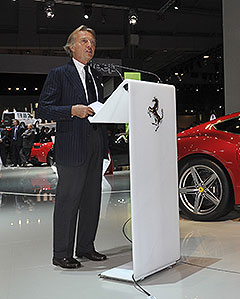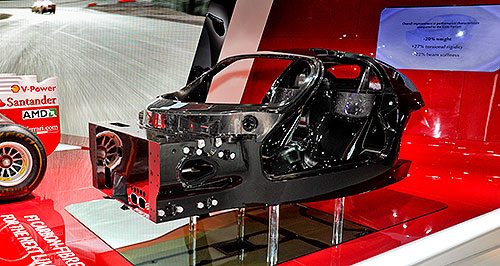Future models - Ferrari - F70Paris show: Ferrari confirms F70 will be a hybridPrancing force: The Ferrari F70 supercar’s ground-breaking carbon-fibre monocoque tub in Paris. Ferrari to launch Enzo replacement in early 2013 with carbon tub and hybrid power28 Sep 2012 By DAVID HASSALL in PARIS FERRARI chief Luca di Montezemolo confirmed at the Paris Motor Show yesterday that the company’s flagship Enzo replacement – widely known as the F70 – will be launched in early 2013 and will be powered exclusively by a hybrid powertrain. Revealing the supercar’s ground-breaking carbon-fibre monocoque tub, Mr Montezemolo said the Enzo replacement would be the company’s first hybrid. He also said that Ferrari’s experience in carbon-fibre construction methods through its championship-leading F1 team would advance the material’s use in a production car. The chassis on display revealed large cut-outs in the roof to provide easier access for occupants lucky enough to step into the F70, and suggesting the possibility of doors that open slightly upwards as well as outwards. Although Ferrari released no technical details of the hybrid powertrain, it will be the V12-based Hy-KERS system announced at the Beijing motor show a few months ago. This set-up features an electric motor mounted to the dual-clutch transmission, providing a short boost in performance, as in Formula One racing.  Left: Ferrari chief Luca di Montezemolo. Left: Ferrari chief Luca di Montezemolo.Mr Montezemolo said the transfer of F1 technology was crucial in producing an “extremely light and extremely rigid” chassis for the limited-edition Prancing Horse. Ferrari claims the chassis – which is to be built entirely in-house – will be 20 per cent lighter than the Enzo’s, despite the extra weight required to house the hybrid components and to meet regulatory obligations. As well as being lighter, the tub is claimed to be 27 per cent better for torsional rigidity and 22 per cent for beam stiffness. It was produced by an internal working group that included “an important contribution” by Rory Byrne, the South African designer behind Ferrari’s remarkable F1 world championship successes since 2000. “Ferrari drew on its vast experience in working with composites for single-seaters for its new hybrid model, which will be produced in a limited-edition, special series,” said Ferrari. “For this model, Ferrari chose not to use the industrial carbon-fibre manufacturing techniques, such as RTM (Resin Transfer Moulding), normally adopted in the automotive sector as they did not meet the quality and functional standards Ferrari set itself. “The chassis uses four different types of carbon-fibre and is hand-laminated then cured in autoclaves following engineering processes which optimise the design by integrating the different components.” Trickle-down technology from F1 also features in the hybrid powertrain, which is claimed to result in the motor and its electronic control unit providing precise torque management that can be used to improve a car’s dynamic characteristics in terms of traction control and brake distribution. A motor is also bolted to the front of the engine and provides power to engine ancillaries such as the power steering, brake servo and air-conditioning systems, altering its drag on the engine based on the level of energy in the batteries.  Read moreAll motor show Alfa Romeo Alfa Romeo Abarth Abarth Alpine Alpine Alpina Alpina Audi Audi Aston Martin Aston Martin BMW BMW Bentley Bentley Chery Chery Brabham Brabham Chrysler Chrysler Chevrolet Chevrolet Cupra Cupra Citroen Citroen DS DS Dodge Dodge Fiat Fiat Ferrari Ferrari Foton Foton Ford Ford Great Wall Great Wall FPV FPV Haval Haval GWM GWM Honda Honda Holden Holden Hummer Hummer HSV HSV Infiniti Infiniti Hyundai Hyundai Jaguar Jaguar Isuzu Isuzu Kia Kia Jeep Jeep Land Rover Land Rover Lamborghini Lamborghini Lexus Lexus LDV LDV Mahindra Mahindra Lotus Lotus Mazda Mazda Maserati Maserati Mercedes-AMG Mercedes-AMG McLaren McLaren MG MG Mercedes-Benz Mercedes-Benz Mitsubishi Mitsubishi Mini Mini Opel Opel Nissan Nissan Peugeot Peugeot Pagani Pagani Proton Proton Porsche Porsche Renault Renault Ram Ram Rover Rover Rolls-Royce Rolls-Royce Skoda Skoda Saab Saab SsangYong SsangYong Smart Smart Suzuki Suzuki Subaru Subaru Toyota Toyota Tesla Tesla Volvo VolvoMotor industry news |
Click to shareAll motor show Alfa Romeo Alfa Romeo Abarth Abarth Alpine Alpine Alpina Alpina Audi Audi Aston Martin Aston Martin BMW BMW Bentley Bentley Chery Chery Brabham Brabham Chrysler Chrysler Chevrolet Chevrolet Cupra Cupra Citroen Citroen DS DS Dodge Dodge Fiat Fiat Ferrari Ferrari Foton Foton Ford Ford Great Wall Great Wall FPV FPV Haval Haval GWM GWM Honda Honda Holden Holden Hummer Hummer HSV HSV Infiniti Infiniti Hyundai Hyundai Jaguar Jaguar Isuzu Isuzu Kia Kia Jeep Jeep Land Rover Land Rover Lamborghini Lamborghini Lexus Lexus LDV LDV Mahindra Mahindra Lotus Lotus Mazda Mazda Maserati Maserati Mercedes-AMG Mercedes-AMG McLaren McLaren MG MG Mercedes-Benz Mercedes-Benz Mitsubishi Mitsubishi Mini Mini Opel Opel Nissan Nissan Peugeot Peugeot Pagani Pagani Proton Proton Porsche Porsche Renault Renault Ram Ram Rover Rover Rolls-Royce Rolls-Royce Skoda Skoda Saab Saab SsangYong SsangYong Smart Smart Suzuki Suzuki Subaru Subaru Toyota Toyota Tesla Tesla Volvo VolvoMotor industry news |















Facebook Twitter Instagram